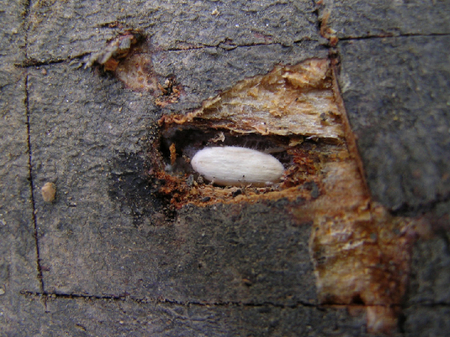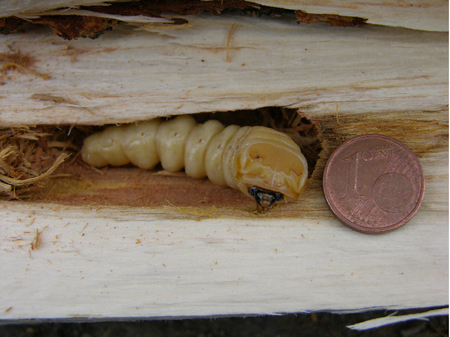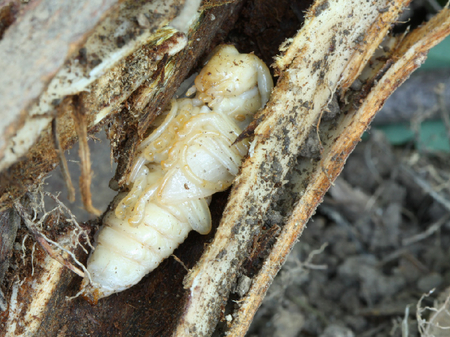Citrus long-horned beetle
Anoplophora chinensis
Profile
The name citrus longhorned beetle is misleading because, although it primarily attacks citrus trees in its native Asia, it also causes considerable damage to numerous other deciduous trees. In the European Community, the citrus longhorned beetle is listed as a quarantine pest and is therefore notifiable.
Appearance
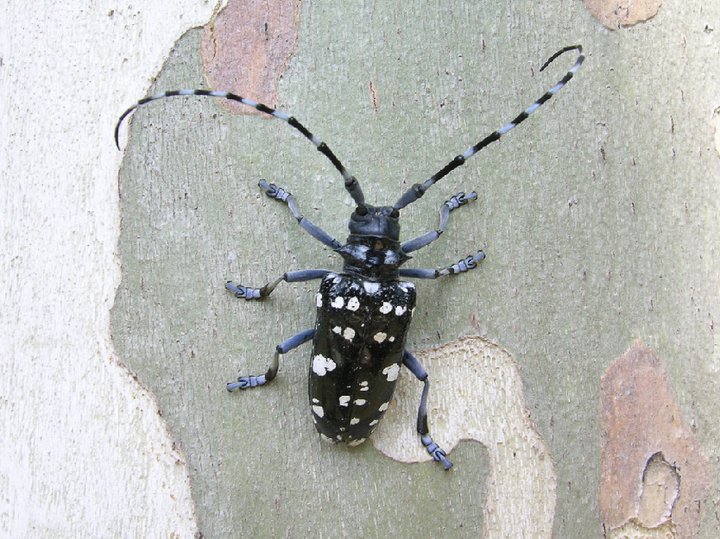
The citrus longhorn beetle, a member of the longhorn beetle family (Cerambycidae), is very conspicuous and hard to confuse in appearance with other native longhorn beetle species. It is 2-4 cm long, shiny black with irregular light spots on the elytra and has long, blue-white ringed antennae. The elytra base is granular. Males are usually smaller than females and have longer antennae that extend beyond the posterior end (elytra).
The cream-colored larvae have an elongated, cylindrical body and are legless. After hatching, they are about 5 mm long and grow up to 50-60 mm in size as they develop.
The eggs are about 5-6 mm long and creamy white, yellow-brown just before larval hatching.
Biology
In Asia, the beetles hatch from May to about October (with a focus in May to July), in Central Europe from about June to August. The females begin laying eggs ten days after hatching. To do this, they cut T-shaped slits in the bark of above-ground roots or the base of the trunk with their mouthparts. A female lays an average of up to 70 eggs individually in her lifetime. After about one to three weeks, the larva hatches and feeds first in the trunk under the bark (cambial region). Later, the larval ducts spread into the woody tissue (sapwood and heartwood) of the lowest parts of the trunk and roots. The larvae then already reach a size of 5 - 6 cm. Hibernation takes place in the larval stage and pupation then in spring. The pupal stage lasts about four to six weeks, after which the beetle hatches through circular bores (about 1 - 1.5 cm in diameter) at the base of the trunk and on above-ground roots. Maturing adult feeding occurs on leaves, petioles, and the bark of young twigs.
The development cycle of the citrus longhorned beetle usually lasts one year. However, depending on climatic conditions, the cycle can be as long as two years, such as in Central Europe.
Damage symptoms
Infested trees are very difficult to detect due to the hidden lifestyle of the larvae. The first signs of infestation are often drilling chips at the base of the trunk and in the root area, which are caused by the feeding activity of the larvae. The circular, approx. 1 cm large boring holes of the hatched beetles are also signs of an infestation with the citrus longhorned beetle. Other indications of an occurrence are finding the conspicuous beetles themselves and the feeding marks of the citrus longhorned beetles on leaves and twigs (maturity feeding). The ripening feeding of the beetles additionally leads to wilting symptoms.
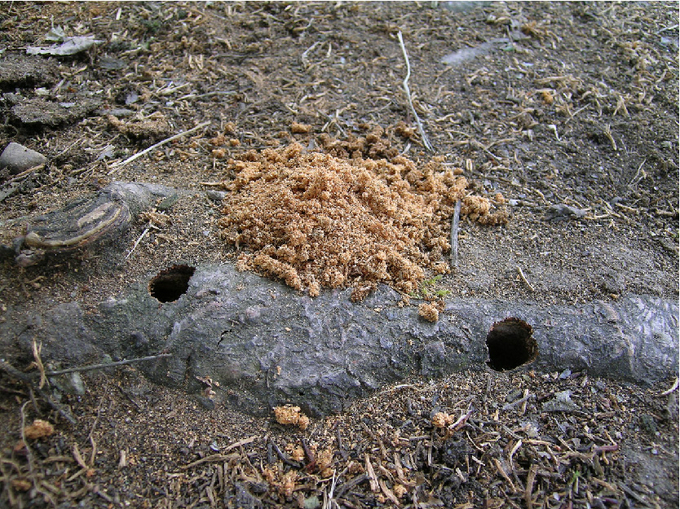
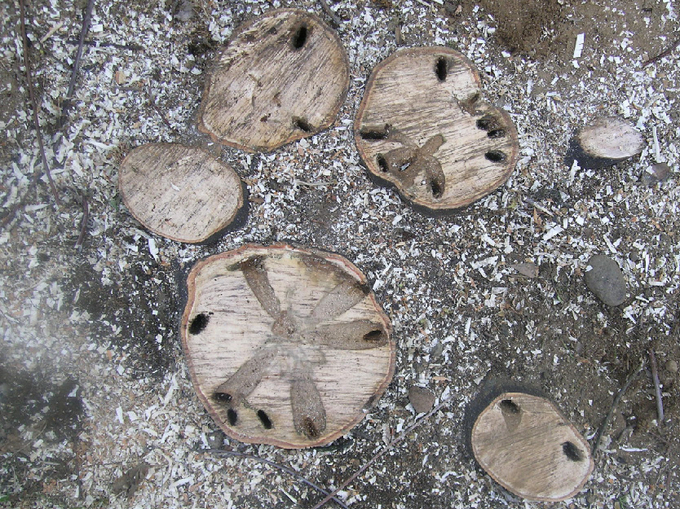
Host plants
The citrus longhorned beetle can use plants of more than 20 families as host plants; in its native Asia, citrus plants(Citrus spp.) are preferred. However, the possible host plant range includes numerous deciduous woody plants, including fruit and ornamental woody plants. In Asia, the host plant range is wider; here, conifers of the genera Cryptomeria spp. and Pinus spp. are also included.
Common host plants are: Maple(Acer spp.), Apple (Malus spp.), Pear (Pyrus spp.), Birch (Betula spp.), Beech (Fagus spp.), Alder(Alnus spp.), Hornbeam (Carpinus), Dogwood (Cornus spp.), Hazelnut(Corylus spp.), Curly Myrtle (Lagerstroemia spp.), Poplar (Populus spp.), sycamore(Platanus spp.), rose (Rosa spp.), elm (Ulmus spp.), willow(Salix spp.), white-flowered horse chestnut(Aesculus hippocastanum), hawthorn (Crataegus spp.), citrus (Citrus spp.), dwarf loquat (Cotoneaster spp.), plum and cherry(Prunus spp.).
Distribution
Originally, the citrus longhorn beetle originates from East Asia (China, Japan, Korea) occasionally it also occurs in Malaysia, Myanmar, Philippines, Sumatra, Taiwan and Vietnam.
About 20 years ago, there were the first introductions to North America and Europe (in 2000 for the 1st time in Italy), of which some outbreaks were eradicated. Detailed information can be found in the EPPO Global Database.
Propagation and transmission
The greatest risk of spread or introduction of the citrus longhorned beetle is the trade of plants for planting. Especially in imported maple trees and bonsais, e.g. fan maple(Acer palmatum), beetle larvae, eggs and pupae may already be present unnoticed. However, citrus longhorned beetles can also be unintentionally introduced with wooden shipping crates and containers and wooden pallets.
The natural distribution of the beetles seems to be rather very localized to short distances (less than 400 m, usually to the neighboring tree) and is rarely further than about 2.5 km. Environmental factors, such as climatic conditions, host plant availability, and beetle population density, are the most important factors influencing dispersal behavior.
Economic importance
The massive damage is caused by the feeding tunnels of the larvae in the trees. They go deep into the wood and on the one hand reduce the stability of the trees (hollowing of the base of the trunk), on the other hand they interrupt the sap and nutrient transport, and the tree dies as a result. The holes drilled by the pest are also ideal entry points for wood-decomposing fungi.
Prevention and control
As an immigrant in Europe, the citrus longhorned beetle has practically no natural enemies, which is why early detection through targeted controls is very important for successful control. However, due to their predominantly hidden lifestyle, both detection and control of the beetles is very difficult.
Preventive measures
- Targeted visual and mechanical (destructive) inspections for beetles, larvae, boring dust, boring holes and traces of maturing beetle feeding
- Use of sniffer dogs for a more effective and non-destructive measure to detect citrus longhorned beetles before they spread into the field. Sniffer dogs trained for this purpose can sniff out the developmental stages of longhorned beetles hidden in the wood and roots.
- Use of specific attractants (pheromones); but traps are not yet sufficiently efficient.
Control measures
- Clearing of infested trees is currently the only effective measure to destroy larval and pupal stages of the beetles and to deprive the adult beetles of their food and development basis.
- Biological control methods using entomopathogenic fungi, nematodes or parasitic insects are still in the experimental stage.
- Chemical control: in Austria there is no possibility of control with chemical pesticides, as there are currently no approved preparations for the control of longhorned beetles.
Control measures are ordered by the responsible official plant protection services in the provinces.
Phytosanitary status
The citrus longhorned beetle is listed as a priority quarantine pest in the EU and is therefore subject to legal regulations to prevent its introduction and spread in the member states. The presence of the citrus longhorned beetle must therefore be reported.
Specialist information
Publications
Lethmayer, C., 2013 First data on the dispersal and potential spread of Anoplophora spp. Journal of Entomological and Acaralogical Research 45(s1).
Projects
EU-ERANET EUPHRESCO-I-Project ANOPLORISK: "Risk Management for the EC listed Anoplophora species, A. chinensis and A. glabripennis", 15.12.2010 - 15.12.2012
Last updated: 16.12.2025
automatically translated
